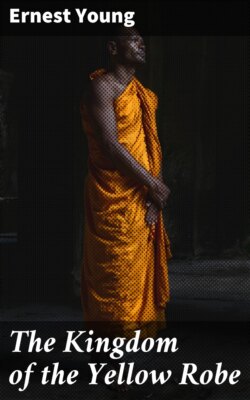The Kingdom of the Yellow Robe

Реклама. ООО «ЛитРес», ИНН: 7719571260.
Оглавление
Ernest Young. The Kingdom of the Yellow Robe
The Kingdom of the Yellow Robe
Table of Contents
PREFACE
TO. MY WIFE
CHAPTER I. STREET SCENES IN THE VENICE OF THE EAST
CHAPTER II. BY "KHLONG" AND RIVER
CHAPTER III. THE CHILDREN
CHAPTER IV. THE SHAVING OF THE TOP-KNOT
CHAPTER V. COURTSHIP AND MARRIAGE
CHAPTER VI. DOMESTIC LIFE AND CUSTOMS
CHAPTER VII. DOMESTIC LIFE AND CUSTOMS (continued)
CHAPTER VIII. POPULAR AMUSEMENTS
CHAPTER IX. OUTSIDE THE CAPITAL
CHAPTER X. THE CULTIVATION OF RICE
CHAPTER XI. LAWS AND LEGISLATION
CHAPTER XII. CEREMONIES FOR THE DYING AND THE DEAD
CHAPTER XIII. THE ORDER OF THE YELLOW ROBE
CHAPTER XIV. AMONG THE TEMPLES
CHAPTER XV. AMONG THE TEMPLES (continued)
CHAPTER XVI. RELIGIOUS CEREMONIES
CHAPTER XVII. RELIGIOUS CEREMONIES (continued)
CHAPTER XVIII. RELIGIOUS CEREMONIES (continued)
CHAPTER XIX. THE PILGRIMAGE TO PRABAT
CHAPTER XX. THE ELEPHANTS
FOOTNOTES:
Отрывок из книги
Ernest Young
Being Sketches of the Domestic and Religious Rites and Ceremonies of the Siamese
.....
The rickshaw was borrowed from Japan; the "gharry" has been imported from India. It is a square box-like structure, the upper half being fitted with sliding windows similar to those in the door of a London four-wheeler. These windows, when open, admit of a free circulation of air, and they can easily be closed to keep out either rain, dust, or sun, at the will of the passenger. The sliding window-frames are always badly fitted, and they rattle and shake with such a terribly deafening noise, that two people sitting side by side, are compelled to shout when they wish to address each other. Riding in these coaches gives one the sensation of being a kind of marble inside a gigantic rattle-box that is being vigorously shaken for the driver's amusement. The majority of the gharries are not in a very much better condition than the rickshaws. The harness is generally made of rope or string, instead of leather, and even if a leather strap or trace is visible, it is nearly always in two or three pieces temporarily connected with string. At very short intervals of time and space, the driver is compelled to descend and repair as best he can the broken connections. These drivers are chiefly Siamese or Malays, and so many of them have adopted the red Turkish fez as a head-dress, that it can safely be taken as the badge of coachmen. In fine weather both Malay and Siamese drivers wear their own national costumes, but should it rain, they promptly divest themselves of every stitch of clothing except a cloth round the loins. They place their garments in a box under the seat, and drive about in a state of almost perfect nudity until the sun reappears and dries them with his rays, when they once more clothe themselves in their native apparel.
The "omnibus" is a variation of the English one, with extensive and important modifications. It is of local construction, and without springs. It consists of a long shallow box on four wheels. A rickety roof is supported by equally rickety pillars, and serves to keep out the sun and rain. Omnibuses are very popular amongst the poor, on account of their exceedingly low fares, several miles being travelled for a few cents. Every kind of vehicle is crowded to its fullest capacity. A rickshaw will ordinarily hold two; you may often see four or five in one. A gharry should carry four, but by crowding inside and piling one person on top of the other, with the addition of a couple hanging on behind, one on each door-step, and one on each hub of the wheels, a whole family manages to get conveyed to its destination by means of a single conveyance. Omnibuses are similarly crowded and packed, to an extent which is only possible on account, first, of the absence of any law to prevent it, and secondly, of the genial good-temper of the natives themselves.
.....